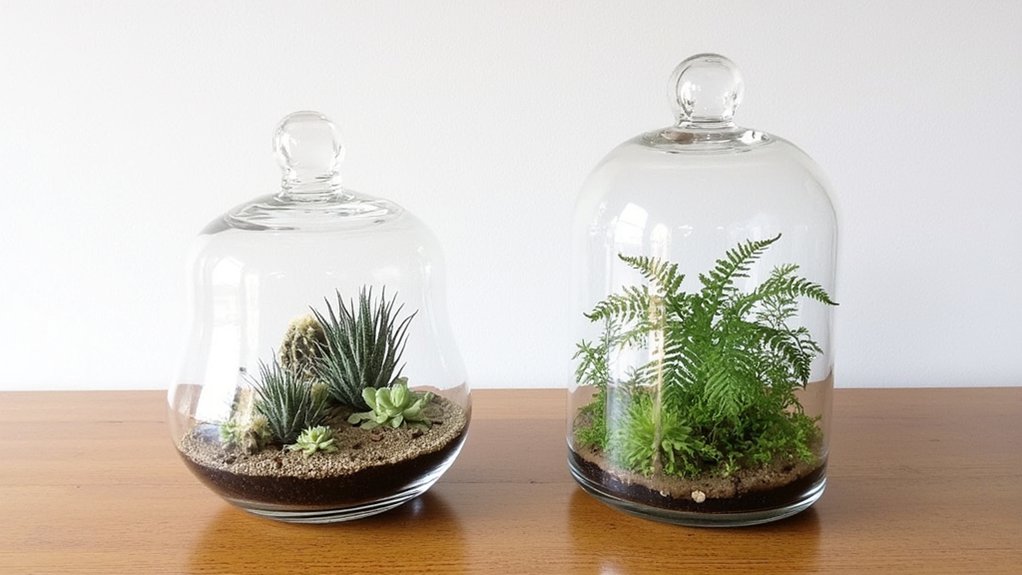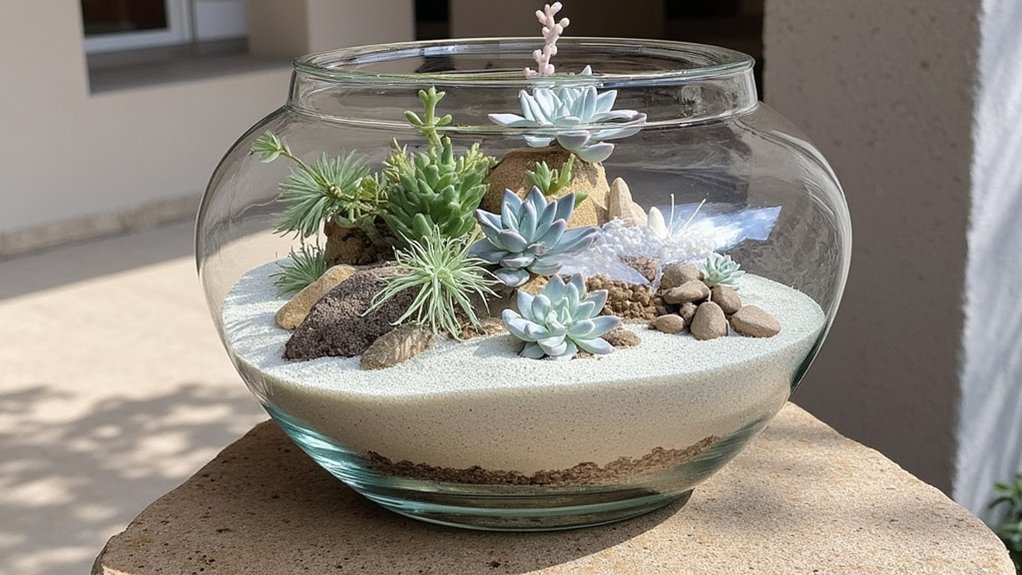If you’ve ever struggled with keeping your leafy friends alive, an open plant terrarium might be your perfect gardening match. You’ll find these miniature landscapes offer a wonderful blend of creative expression and low-maintenance care, making them ideal for both novice and experienced plant enthusiasts. Before you start arranging your succulent sanctuary, though, there’s a vital distinction between open and closed terrariums that’ll determine your entire care approach.
Contents
- 1 Understanding Open vs. Closed Terrariums
- 2 Selecting the Right Container and Location
- 3 Choosing Suitable Plants for Open Terrariums
- 4 Essential Tools and Materials
- 5 Creating the Perfect Soil Mix
- 6 Proper Watering Techniques and Schedule
- 7 Maintaining Optimal Light Conditions
- 8 Managing Temperature and Humidity
- 9 Pruning and Cleaning Your Terrarium
- 10 Common Problems and Solutions
Understanding Open vs. Closed Terrariums

While both types of terrariums create stunning miniature landscapes, open and closed terrariums require distinctly different care routines. Open terrariums feature a wide mouth or no lid at all, allowing constant airflow and lower humidity levels that suit drought-tolerant plants like succulents and cacti.
Closed terrariums, on the other hand, create their own miniature water cycle. You’ll find them completely sealed with a lid, trapping moisture inside which makes them perfect for tropical plants that thrive in humidity.
If you’re just starting out, you’ll find open terrariums easier to maintain since they’re more forgiving with watering and don’t develop condensation issues.
Selecting the Right Container and Location
Two key factors will determine the success of your open terrarium: a properly sized container and a suitable location. Choose a vessel that’s at least 6 inches deep with a wide opening of 8-12 inches to allow adequate airflow and easy plant maintenance. Glass containers work best, but avoid those with lids or narrow necks.
Place your terrarium in a spot that receives bright, indirect sunlight, ideally 3-4 feet from an east or north-facing window. Don’t position it in direct sun, as this can create excessive heat and damage your plants. The room temperature should stay between 65-80°F for ideal growth.
Choosing Suitable Plants for Open Terrariums

Selecting the right plants means the difference between a thriving terrarium and a failed experiment. For open terrariums, you’ll want drought-tolerant species that thrive in low to medium humidity. Choose succulents like Echeveria, Haworthia, or Crassula, which only need watering every 7-10 days.
Air plants (Tillandsia) and small cacti work exceptionally well, requiring minimal soil contact and just 2-3 light mists weekly. You can also incorporate hardy herbs like mini varieties of rosemary or thyme, keeping them trimmed to 3-4 inches tall.
Remember to select plants that won’t outgrow your container’s dimensions, maintaining at least 2 inches of space between each specimen.
Essential Tools and Materials
Creating a successful open terrarium requires a specific set of tools and materials to guarantee proper assembly and maintenance. You’ll need a clear glass container at least 6 inches deep, horticultural charcoal, well-draining potting soil, and decorative pebbles for drainage.
Essential tools include long-handled tweezers for precise plant placement, a spray bottle for misting, small pruning scissors, and a watering can with a narrow spout. Don’t forget a soil scoop or small trowel for substrate placement.
For cleaning and maintenance, keep microfiber cloths and a soft brush nearby to remove dust and debris from both plants and container surfaces.
Creating the Perfect Soil Mix

Because successful plant growth depends heavily on proper soil composition, you’ll need to carefully blend several key ingredients for your terrarium. Mix three parts potting soil with one part perlite and one part activated charcoal, ensuring proper drainage and preventing bacterial growth.
For tropical plants, add a handful of sphagnum moss to increase moisture retention. You’ll want to sift out any large chunks or debris, creating a uniform texture that’s neither too compact nor too loose. Finally, blend in a small amount of worm castings or slow-release fertilizer pellets to provide essential nutrients for long-term growth.
Proper Watering Techniques and Schedule
Proper watering stands as one of the most essential yet delicate aspects of terrarium care. You’ll need to water your open terrarium every 7-10 days, but always check the soil moisture first by inserting your finger about 1 inch deep. If it’s dry at that depth, it’s time to water.
Use a small watering can with a narrow spout or a spray bottle set to stream mode. Apply water directly to the soil, not the plants’ leaves, using about 2-3 tablespoons per 6 inches of terrarium diameter. Watch for water collecting at the bottom – if you see pooling, you’ve added too much.
Maintaining Optimal Light Conditions
Since open terrariums lack a sealed environment, finding the right light balance becomes crucial for your plants’ survival. Place your terrarium in bright, indirect sunlight, ideally 3-5 feet from an east or north-facing window, where it’ll receive 4-6 hours of filtered light daily.
Watch for signs that’ll tell you if the light isn’t right. If leaves become pale or stretched, they need more light. If they’re browning or wilting, they’re getting too much. During summer months, you’ll need to adjust positioning, as the sun’s intensity changes. Try rotating your terrarium 90 degrees weekly to guarantee even growth.
Managing Temperature and Humidity
While closed terrariums create their own microclimate, open terrariums need your help maintaining the right balance of temperature and humidity. Keep your terrarium’s temperature between 65-80°F (18-27°C), and avoid placing it near heating vents or air conditioners that can cause sudden fluctuations.
To maintain proper humidity, mist your plants 2-3 times weekly with filtered water, focusing on the leaves and soil surface. During winter months, when indoor air becomes drier, you’ll need to mist more frequently. If you notice condensation building up on the container’s walls, reduce watering and increase air circulation.
Pruning and Cleaning Your Terrarium
To keep your open terrarium thriving, you’ll need to perform regular maintenance through pruning and cleaning. Using sterilized scissors, trim yellowing leaves, dead foliage, and overgrown stems every 2-3 weeks. Don’t let plants grow taller than 2/3 of your container’s height.
Clean the glass walls monthly with a gentle vinegar solution (1:4 ratio with water) and a microfiber cloth. Remove any fallen debris, moss buildup, or mineral deposits. Check for signs of mold or algae growth, especially in corners and around the substrate’s edge, and gently scrape away using a wooden stick.
Remember to inspect your terrarium’s drainage layer during cleaning sessions, removing any accumulated organic matter.
Common Problems and Solutions
Even with regular maintenance, open terrariums can develop issues that need addressing. If you’re seeing yellowing leaves, you’ll need to adjust your watering schedule or improve drainage. Brown leaf tips often indicate low humidity, which you can fix by misting more frequently.
Watch for pest infestations, particularly fungus gnats and mealybugs. You can treat these with neem oil or by removing affected plants. Mold growth, appearing as white fuzzy patches, requires immediate attention – reduce watering and increase air circulation.
If your plants are stretching or becoming leggy, they’re likely not getting enough light. Move your terrarium closer to a window or add supplemental grow lights.
